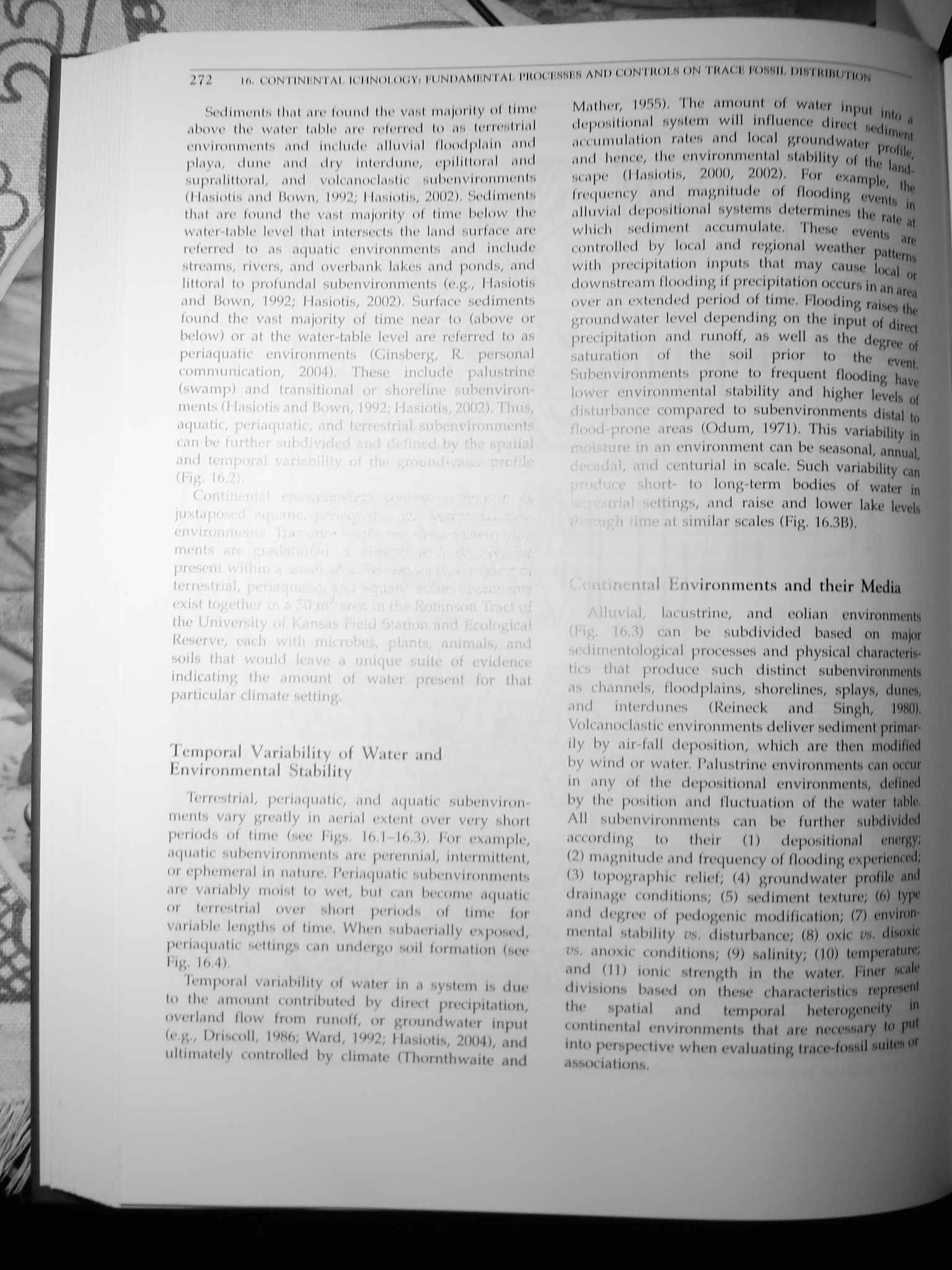dsc08784 (3)

272 16. CONTINliNTAI. K IINOI.OOYi RJNDAMIINTAI, PH0OUŚBHH ANI) ( ON I HOI.HON TRACH FOIIII. l)IH II(/m)'||ON
Scdlmenls Ihot iin* found the v.ml mfljorlty ol Ilnu* oht>\'i* ilu1 Witter labie are relerred In oh ltarri*h!rliil eiwironmenls .nul Indude olluviol floodplnln .md pl.iy.i, duiit* .md tiry iiilt,rdimi,/ piiilillnr.il .md stipr.ilillnr.il, and volcanoclastic snheiwimnmenls (Hasiolis and Uown, 1992; Hnsłotia, 2002), Secltfmenls l hol on* found the v<ist mnjority of linii* helów I lu * wal er-labie level I ho I inlerseiis Ihe land surface are referreil In as acjualie eiwironmenls and inciude slreams, rivers, and overbank lakes and pnnds, and littoral In prnlundal subeiwironments (e.g., I loniolis and Uown, 1992; Hasiotis, 2002). Surface sedlments found Ihe vasl mnjority of U me near In (above or below) or al Ihe walor-tnble level are reforred to as periaqualic eiwironmenls (Ginsberg, R. personal communication, 2004). Th esc includc paluslrine (swamp) and transitional or shoreline subeiwiron-ments (I lasiotis and Bown, 1992; Hasiotis, 2002). Tlius, acjuatic, periaaualic, and Łerrestrial subeiwironments can be further subdivided and defined by the spatial and tein pora I variabi)ity of the groundw&Wtii' profil® (Fig. 16.2).
Continental enyaww-.wtó-f ci
juxtapofjpd aouatlc, S
menie are gradftwIlPM. goi present withm a łerrestrial, pcrincp r .v
exiel logelher in a 50 aren m rhr Roim.sou Traci of Ihe Univc*rsily of Kansas FhjIiJ blauon and Ecological Reserve, each will. mit robę-;, olani?;, .mimals, and eoils I hal would leave a uniciue su ile of evidence indicating Ihe amount of waler present for that parlicular climate seliing.
Tcmporal Variability of Waler and lin vi ron in en tal Stabili ty
Terre,slrial, p<!na<|i.mlic, .md acjuatic subeiwiron-menls vary greally in .terial exlcnl over very short periodu of limo (sec Figs. 16,1 16.3). hor exanipie, •ił|ii.iIi«- suhenvironmenls are perenni.il, intennitlent, or ephemer.il in naturę. IVri.u|unlii' i-łubeiwironments are variably mnisi to wet, bul tan betonu* aquatic or terrestrial over short period* of linie for variable lenglhs of limę. When subaerially exposed, periaaualic sellings tan undergo soil forma don (set* Fig. 16.4).
Temporał variabilily of waler in a system is duo lo ilu* amount contributed by di red predpitation, overland flow from runoff, or groundwaler inpul (e.g., Drlscoll, 1986; Ward, 1992; Hasiolis, 2004), and ullimalely conlmlled by climate (Thornlhwaite and
Mather, l!955), Ihe amonnl of waler input Into tlepoHllIonal sysiern will Influence dlrect wdim# aecumiilalion rales and local groundwaler profili*
■ nul lienee, the environmenl.il słabliby of Ihe l.iiul-se.ipe (I laslolls, 2000, 2002). For exninpl«, Ilu-freł|iiency and niagniliule of flooding event« in alluvi.il deposilional Systems determlnes the rale al wliich sedimenl accumulate. These c*vents ąra controlled by local and regional wealher patlerns willi predpitation inpuls that may cause local or downslrcam flooding il predpitation oecnrs inanare.i over an exlended period of limę. Flooding raises ihe groundwaler lt*vel depending on Ilu* inpul of dircrl predpitation and runoff, as weli as ihe degrec of saluration of the soil prior to the cvent. Subeiwironments prone to fret|uent flooding havt* lower environmenlaI slabilily and higher levels of disturbnnee compared to subeiwironments distal to I >rone areas (Odum, 1971). This variabilily in ;i:ure in an eiwironment can be seasonal, annual, d, and centuria! in scalę, Such variability can .hor i- lo long-term bodies of wator in sellings, and raise and lower lakę lm*ls r al similar scales (Fig. 16.3B),
icntal Environments and their Media
li.ivi.il, lacustrine, and eollan environnu*nb >.3) can be subdivided based on major sedimenlologic.il processes and physicnl characlcris-tics Iliat produce such distincl subenvironmenls as channels, floodplains, shorelines, splays, dunes, and interdunes (Reineck and Singh, 1980). Volcanoclastic environments deliver sedimenl primar-ily by air lali dcposiition, which are Ihen modifled by wind or waler. Faluslrine eiwironmenls can occur in any ol the deposilional eiwironmenls, tlefinwi by the posili on and fludualion of the waler labie. Ali subeiwironments can be furlher subdiyldrd according lo their (1) deposilional energy;
(2) magniluih* and Ireijuency of flooding experi<,n(i,iJ;
(3) topographic relief; (4) groundwaler profile and d rui nago condilions; (3) sedimenl texlurc; (6) I y jh* and degree of podogonie modification; (7) ciwiron-men lal slabilily va. dislurbance; (H) oxic us. di»nxic W. anoxic condilions; (9) salinily; (10) temperatura; and (II) jonie slrenglh in Ihe waler. Filier siali* divisions based on these charaderistics represenl the spatial and temporal heterogeneity in Continental eiwironmenls that are necessmy to p into |X*rspective when evalualing trace-fossil suitę* or associations.
Wyszukiwarka
Podobne podstrony:
dsc08779 (2) 70 16. CONTINENTAL ICHNOLOGY: FUNDAMENTAL PROCESSES AND CONTROLS ON T
dsc08786 (3) 274 16. CONTINENTAL ICHNOLOGY: FUNDAMENTA!. 1‘ROCESSES AND CONTROLS ON TRACĘ FOSSIL DIS
dsc08787 (3) 274 16. CONTINENTAL 1CHNOLOGY: FUNDAMENTAL PROCESSES AND CONTROLS ON
dsc08789 (3) 276 16. CONTINENTAL ICHNOLOGYi FUNDAMBNTAL PROCESSES AND CONTROLS ON TRACĘ FOSSIL DISTR
dsc08794 (2) 278 16. CONTINENTAI. ICHNOLOGYi FUNDAMENTAL PROCESSES AND CONTROLS ON TRACĘ FOSSIL DIST
dsc08798 (3) 282 16. CONTINENTAL 1CIINOLOGY: PUNDAMENTAL PROCESSES AND CONTROLS ON TRACĘ FOSSIL DIST
dsc08778 (2) FIGURĘ 16.1 Continental realm: biophysicochemical factors. Diagram depicts the and temp
dsc08800 (3) 284 16. CONTINENTAL ICHNOLOGY: FUNDAMENTAL PROCESSES AND CONTROLS ON
130-ZFŚS 73124014311111000010469080 ZFŚS 3 272,16 Stany środków pieniężnych zgodne z
272 (16) 27 A Practical Guide to Feline Dermatology Alternaria spp. 5.1,7.8 Aluminium hyroxide 15.6&
38TREATMENTS JPRS-UMS-92-003 16 March 1992 The Effect of Cycling on the Crack Formation of Austenite
j062 (2) K p 7 7°7® IF TH 16 OTNJ-U£6 G£NJOU S PAPeveRy- ON£ IN THfc KUĆfcKA TH^y WILU JU6T QUXT&nbs
JAN2020PLAYING GAMES: DEVICE PERSPECTWE PERCENTAGE OF INTERNET USERS AGED 16 TO 64 WHO PLAY YIDEO GA
16 MICHAŁ NORBERT FASZCZA zachował się ani jeden przykład udziału fabri w kampanii wojennej i gdyby
16. The body composition analyscr providcs Information on the exter-nal appearance
więcej podobnych podstron